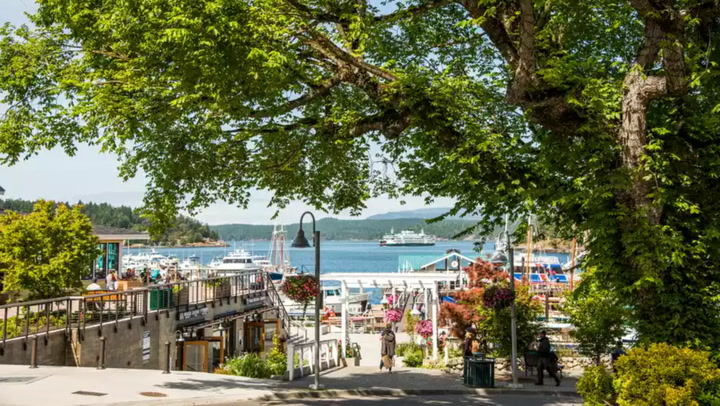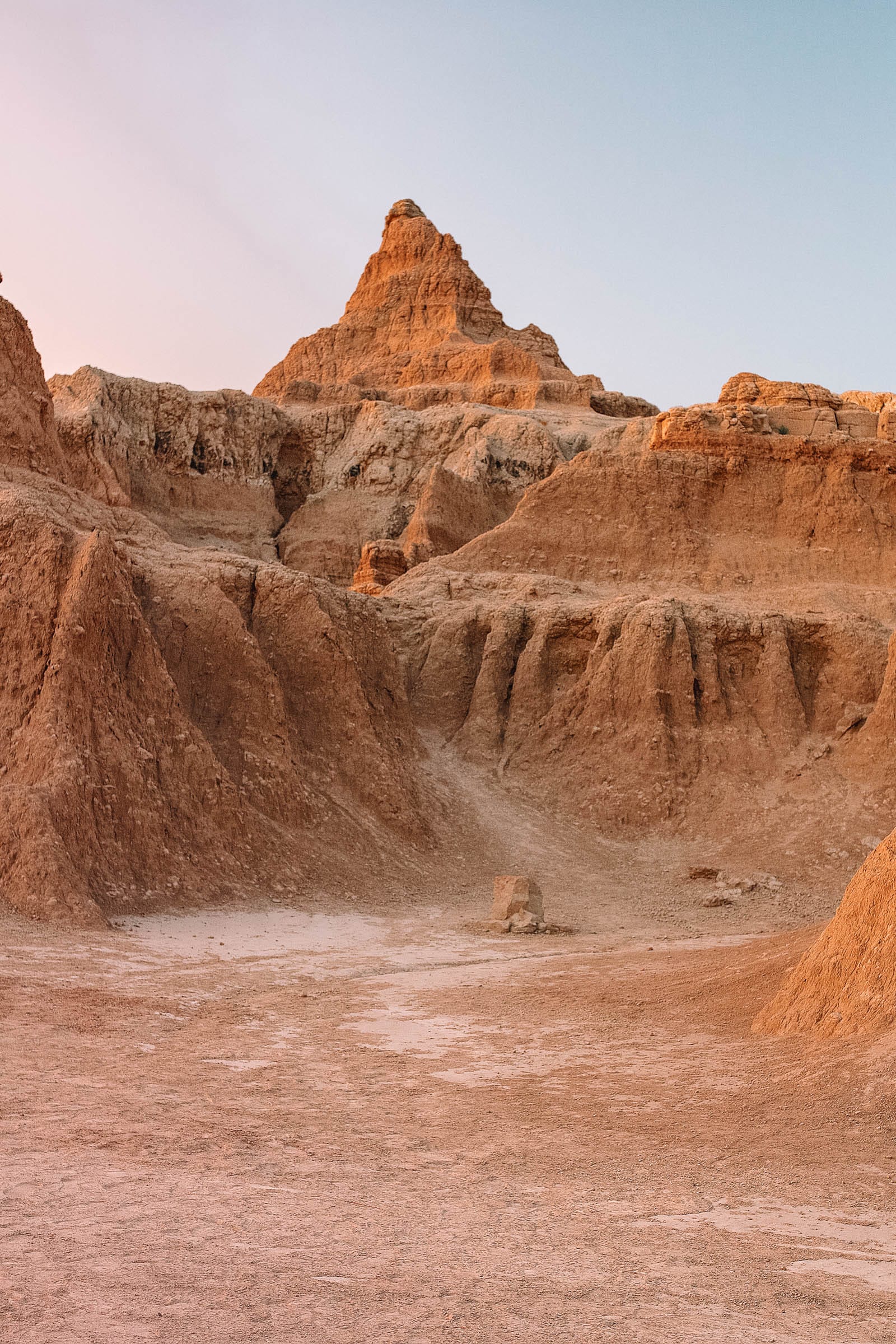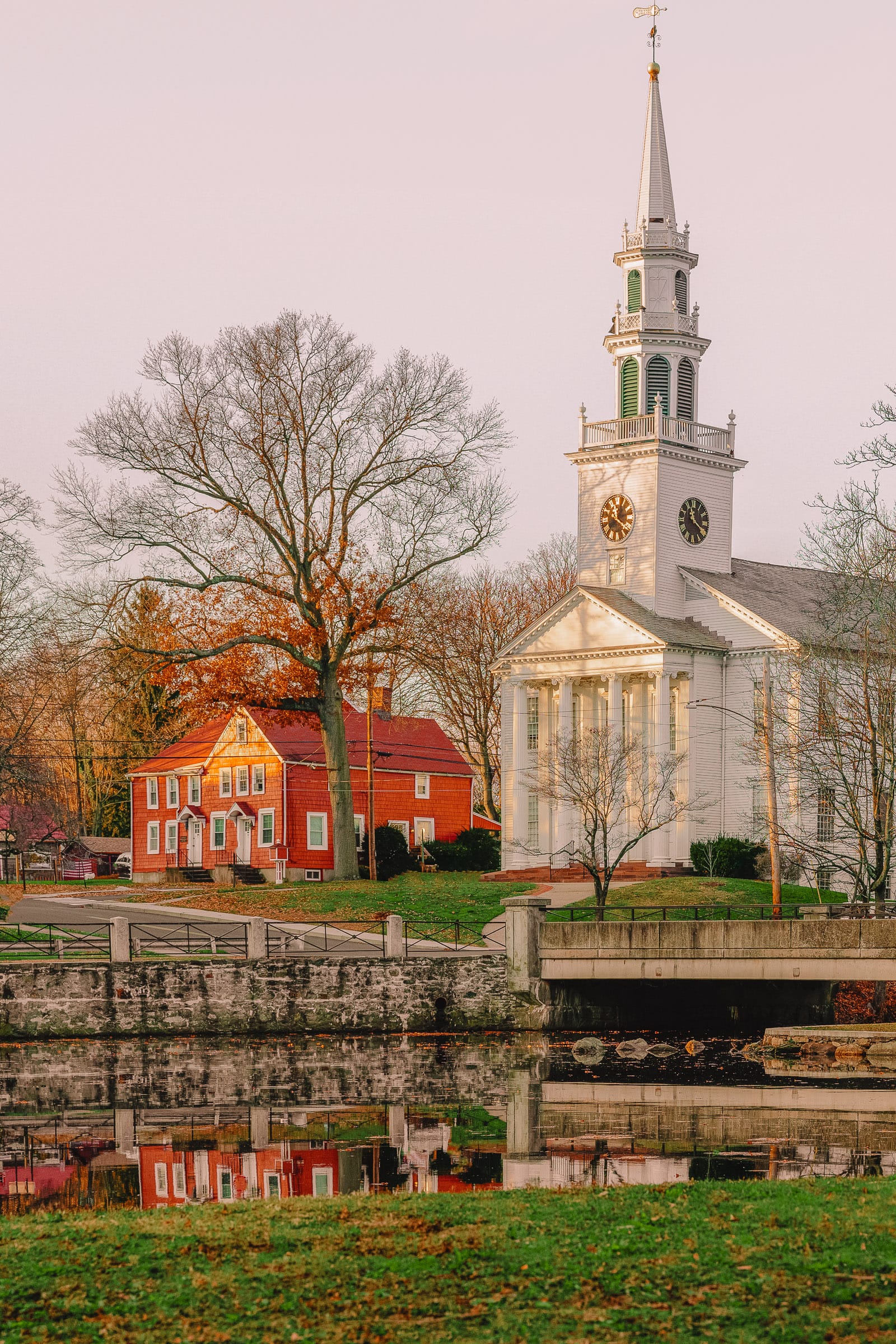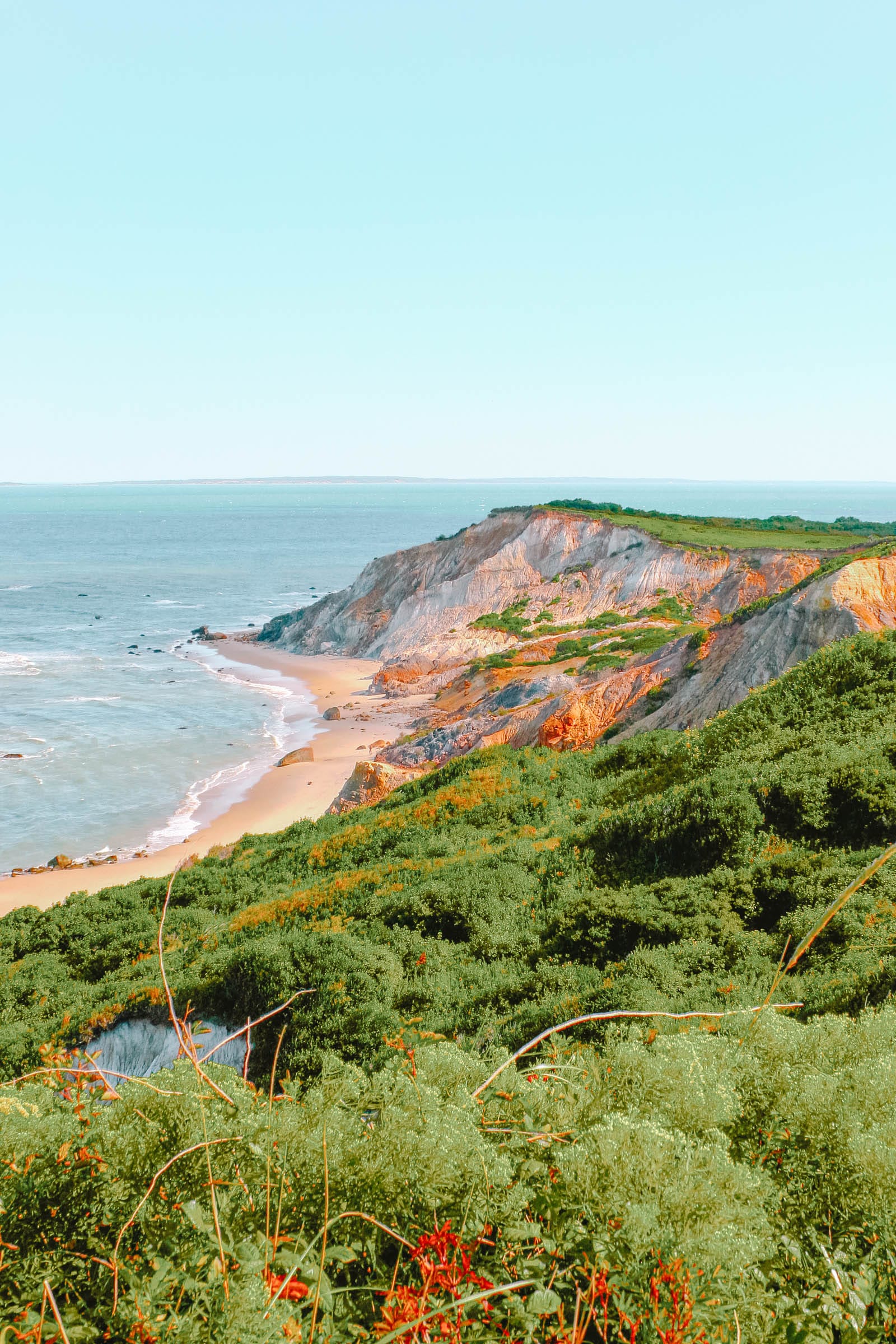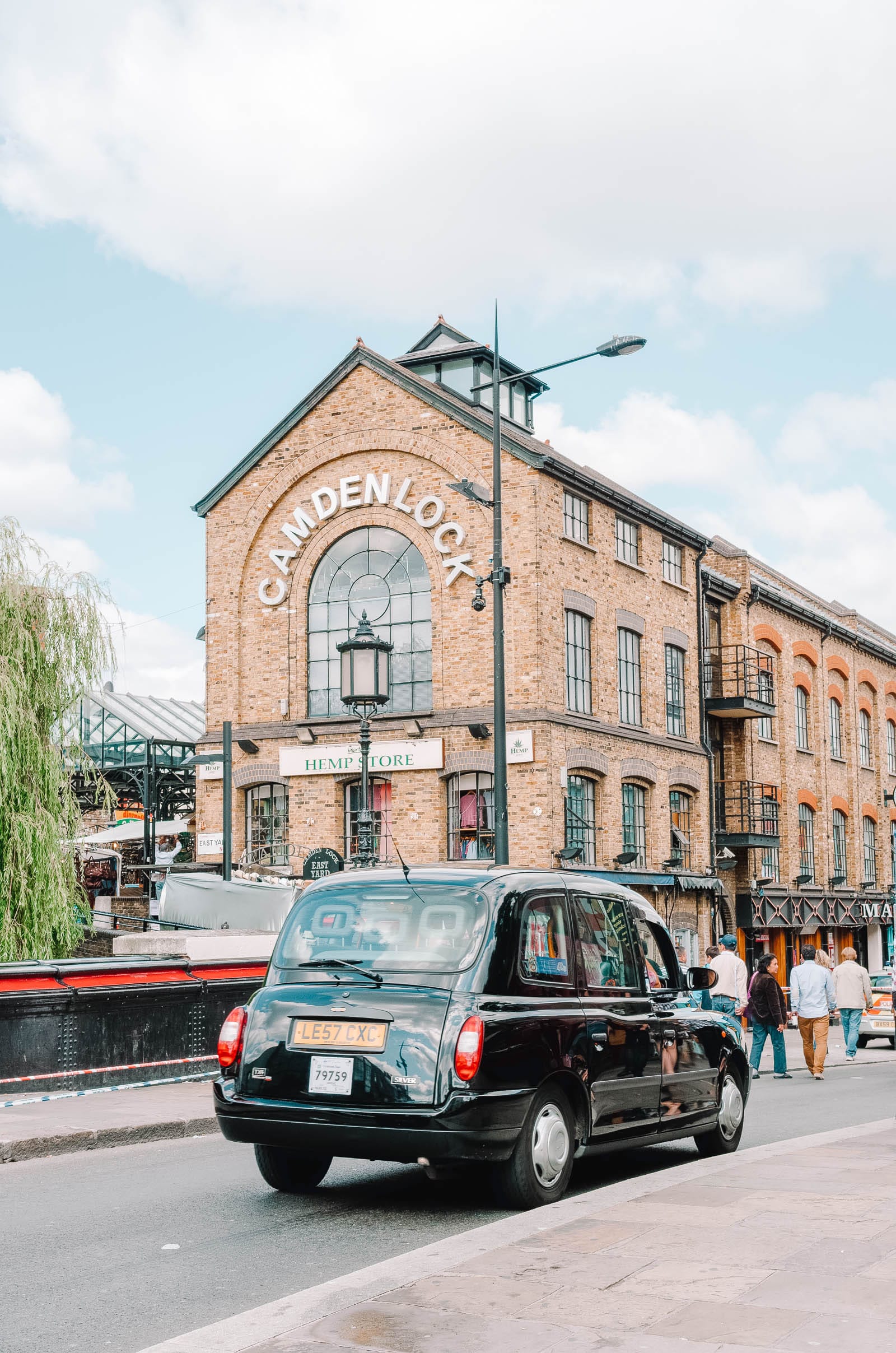Explore Washington’s San Juan Islands
Hike, bike, eat, drink, and whale watch your way around Washington’s beautiful San Juan Islands.
Watching a mother orca swim through mirror-smooth waters with her playful, leaping calves in tow. Slurping fresh oysters paired with wine made from island grapes. Cycling past country farms and kayaking along remote coastlines. Feeling unmoored from mainland life, embracing the leisurely, comfortable rhythms of a place so in tune with its natural surroundings. These are just some of the reasons to heed the siren call of the San Juan Islands.
Comprising 172 islands, this Pacific Northwest archipelago is scattered throughout northwestern Washington’s Salish Sea. Named by Spanish explorer Francisco de Eliza in 1791, but the ancestral home of Indigenous Coast Salish groups like the Lummi and Samish since time untold, the idyllic islands are known for their evergreen forests, abundant wildlife, rich history, and thriving art scenes. The three main islands of San Juan, Orcas, and Lopez are hubs for outdoor fun like hiking, cycling, sea kayaking, and spotting native wildlife such as whales and 200-plus bird species.
State parks and the San Juan Islands National Wildlife Refuge protect wildlife and the incredible variety of island ecosystems like grasslands and prairies (yes, prairies on an island). With bountiful farms (both the land and ocean variety), orchards, vineyards, and forests, the San Juan Islands are also affectionately referred to as the “gourmet archipelago,” home to nationally lauded restaurants, wineries, distilleries, breweries, cideries, and local makers of artisan goods like fruit preserves and cheese.
Everyone from nature lovers to foodies and even a few billionaires and movie stars find their way to these remote islands. Sure, with no bridge connecting the islands to the mainland, they take a little more effort to reach. But that’s just part of the charm and allure.
Here’s how to plan the ultimate trip to Washington’s San Juan Islands and fall in love with everything the destination has to offer.
How to Travel to the San Juan Islands

For getting to and navigating around the San Juan Islands, do as the locals do and ride the “marine highway” — Washington State Ferries system, which departs from the city of Anacortes, gateway to the San Juan Islands. With direct sailings to San Juan’s Friday Harbor, Orcas Island, Lopez Island, and Shaw Island, the ferries are not only an essential link connecting the islands to the mainland, but they also provide a scenic start to the trip.
Ferry tickets, which cover round-trip travel to and from the San Juan Islands, can be purchased online or at the terminal. While it’s not necessary to buy tickets in advance, it’s recommended that vehicle reservations are made ahead of time, especially in the busy summer months. For island hopping, there are daily sailings between San Juan, Orcas, Lopez, and Shaw, with first-come, first-served non-reservation spots for vehicles. All eastbound inter-island travel is free, for both walk-on passengers and vehicles. If you’re traveling westbound between islands (for example, from Orcas to San Juan’s Friday Harbor), you’ll pay a reduced fee for vehicles.
With airports on San Juan, Orcas, and Lopez islands, you can also take scheduled or charter flights with San Juan Airlines from Bellingham and Anacortes. Kenmore Air and Friday Harbor Seaplanes provide seaplane rides from the Seattle area for, quite literally, a splashy arrival or departure.
Once on the islands, you can get around by car or bike. Rideshare services like Uber and Lyft aren’t available here, but you’ll find local taxi services on each island. For bigger islands like San Juan and Orcas, having your own car or renting one makes it easier to get around.
Where to Eat, Stay, and Play on the San Juan Islands
The San Juan Islands consist of 172 named islands in varying sizes. Some are so small, they disappear at high tide. Others, like Shaw, are residential with little to no tourism infrastructure. And then there are those that are uninhabited for truly off-the-beaten-path exploring, while some, like Blakely and Decatur, are privately owned. Unless you can swing an invite to the exclusive private islands (Bill Gates has a home in the area), the main and biggest islands to explore are San Juan, Orcas, and Lopez.
San Juan Island

Home to lavender farms, historic lighthouses, art and science museums, and an array of shopping and dining experiences, San Juan Island is the second-largest and most populous island, making it a great jumping-off point for your vacation. The main town of Friday Harbor, where the ferry docks, has an easily walkable downtown area, friendly locals, and picturesque views. Travelers can browse galleries with work by Indigenous artists, shop at seasonal farmers markets, and get close to orca skeletons at the educational Whale Museum.

At roughly 20 miles long, the rest of the island is never more than a 20-minute drive away. The Scenic Byway route takes visitors around the entire island to other points of interest, including the American and English camps from the Pig War, the Pelindaba Lavender Farm, the Westcott Bay Sculpture Park, and scenic viewpoints like Lime Kiln Point State Park. Also known as Whale Watch Park, this peaceful spot on the island’s western coast is a popular whale-watching destination along The Whale Trail. Even better, volunteers regularly hang out to answer questions. (What time do the whales come by, you ask? The answer is whenever they want.)
Whale Watching on San Juan Island

Here, locals live alongside bald eagles, foxes, and marine life like harbor seals and Dall’s porpoises, making San Juan one of the best islands for wildlife sightings. However, the hope of seeing whales, especially the orca and killer whale pods that roam the Salish Sea throughout the year, is the holy grail. The area is home to two different types of orcas: southern resident killer whales and transient or Bigg’s killer whales. Humpback whales, gray whales, and minke whales have also been spotted here.
Whale-watching tours run out of Friday Harbor and Roche Harbor at the northern tip of the island throughout the year, with the best chances of sightings between March and October. Western Prince Whale Watching offers thrilling tours in speedy, open-air zodiac crafts with naturalists to answer questions. For larger boats with indoor viewing decks and more comfortable seating, San Juan Safaris‘ whale tours are ideal for families and elderly travelers.
Where to Eat and Drink on San Juan Island
Just steps from the ferry landing, Downriggers is a prime spot for seafood-centric Pacific Northwest fare with waterfront views. Start off with at least one order of the Dungeness crab tots before diving into catch-of-the-day specialties and menu staples like sockeye salmon.
With a sunny outdoor patio and an industrial-chic dining room, San Juan Island Brewing Company is the go-to spot for island-made brews after a long day out on the water. Their award-winning selection includes everything from Czech-style pilsners to lesser-known Norwegian farmhouse ales infused with juniper. Try a preset or custom flight of five before ordering a pint along with hearty upscale pub grub such as salmon sandwiches.
Set back in a sylvan glade of flowering vines and stately trees, the bucolic atmosphere of Duck Soup‘s rustic cabin dining room is the perfect complement to its sophisticated menu. Starting with seasonally inspired cocktails, the food changes throughout the year, utilizing what’s fresh and available from the island’s waters, farms, soil, and woods.

The San Juan Islands also have their own wine scene, part of western Washington’s cool and wet Puget Sound American Viticultural Area. Producing cool climate white wines, San Juan Vineyard is the only winery on the island making vino from estate-grown grapes. These and their eastern Washington-sourced red and rosé wines can be sampled in flight or full-pour form at their countryside tasting room outside Friday Harbor. Specializing in low-intervention natural wines made from eastern Washington grapes and ciders crafted from local or regional apples, Madrone Cellars has a tasting room in Friday Harbor, where you can sample European-style pétillant naturel sparkling wines and hard ciders.
San Juan Island also has its own distillery, which produces small-batch gins, vodkas, liqueurs, and brandies. Some gins, like their Seaside Gin, use locally foraged botanicals like camas root — once a key food for the Coast Salish — and seagrass to evoke the flavors and scents of the island.
Where to Stay on San Juan Island

With a grand lodge, private cabins, yurts, glamping tents, and RV and camping sites, Lakedale is a lovely lakefront property less than 10 minutes from Friday Harbor. Peaceful and quiet, the cozy lodge rooms are ideal for couples, while the cabins are made for larger family gatherings. Guests can sip island-made wine on the terrace, fish for trout or bass in the lakes, or simply unwind by listening to birdsong and watching foxes wander past rooms.
If you prefer to stay right in Friday Harbor, the Tucker House Inn & Harrison House Suites offers a range of accommodations in historic 19th- and 20th-century accommodations close to the ferry landing. Choose between romantic guest rooms with balconies and gas fireplaces, spacious suites, and private cabins. Days start with a fresh gourmet breakfast, and pets get their own sweet welcome with “pupcakes” during check-in.
Orcas Island

Known as the Emerald Isle for its dense forests and lush greenery, the 57-square-mile, horse-shaped Orcas Island is the largest of the San Juans. Home to Mount Constitution, the highest peak in the archipelago, this hilly island offers ample hiking, biking, and other outdoorsy pursuits like kayaking on mountain lakes and camping within old-growth forests. Its many farms and orchards, producing heirloom varietals like Orcas pears, set the stage for fresh, seasonal dining experiences, as well as island-produced cheese, wine, cider, and spirits. Artisan studios and charming galleries can be found in tiny communities and villages throughout the island like Eastsound and Olga.
Encompassing more than 5,000 acres of lakes, forests, wetlands, bogs, and mountain peaks, Moran State Park provides hiking on its 30 miles of trails, camping, kayaking, swimming, and horseback riding. Visiting the summit of Mount Constitution, with its panoramic view of the islands and historic stone watchtower, is a must on any San Juan Islands itinerary — you can hike up or use a paved winding road. Turtleback Mountain Preserve and Obstruction Pass State Park are other great outdoorsy spots for picturesque views. With its mountainous terrain, Orcas Island is also a popular challenge for cyclists, with the winter months offering thrilling mountain biking on seasonal trails.
Where to Eat and Drink on Orcas Island
Start your day with small-batch pastries and bread from Brown Bear Baking in Eastsound. After a morning of outdoor fun, head to Buck Bay Shellfish Farm in Olga. Overlooking a tranquil bay where they grow their own Pacific oysters and clams, this is a great spot to shop for fresh, locally caught fish and Dungeness crab. Visitors can also enjoy a sun-drenched lunch with crab cakes, fish tacos, and crab mac and cheese.
In Deer Harbor, chow down on homemade brisket and ribs at neighborhood hangout Matthew’s Smokehouse. Kingfish and Matia Kitchen are excellent choices for upscale locavore cuisine. Matia was recently a James Beard semifinalist for best new restaurant, so make those reservations now.
For wine, check out the modern farmhouse tasting room at Orcas Island Winery and try flights or pours of sparkling pétillant naturel, white, or red wines. In Eastsound, the Doe Bay Wine Company serves as the tasting room for The Orcas Project, a collaborative initiative between Pacific Northwest winemakers and local Orcas Island artists.
Orcas’ first (and only) microbrewery, Island Hoppin’ Brewery doles out an array of IPAs, ambers, blondes, and red ales, and Orcas Island Distillery turns island grains and apples into award-winning brandies and gins. Finally, before boarding the ferry to depart, soak up the view one last time with a hard cider made from island apples and other fruits at Boathouse Ciderworks.
Where to Stay on Orcas Island

Orcas offers visitors a good mix of camping and quaint, seaside getaways. Located inside Moran State Park, glamping outfit Leanto gives travelers the best of both worlds with their stylish, high-end glamping tents tucked away on private sections in the forest.
For a more traditional stay, head to the Doe Bay Resort & Retreat, situated on 38 acres of waterfront property with cabins, yurts, domes, and outdoor soaking tubs overlooking the bay.
Lopez Island

Encompassing nearly 30 square miles of farms, forests, and quiet bays, laid-back Lopez Island is known as the Friendly Isle. Here, you’ll receive a warm welcome as locals greet guests with the signature Lopez wave. Don’t be surprised if a simple request for directions morphs into a delightful and engaging half-hour conversation.
With its cyclist-aware drivers, quiet country roads, and mostly flat terrain, Lopez Island is best explored by bike. After getting off the ferry at the island’s northern tip, hop onto a bike rental delivered by Village Cycles. You can head to wilderness preserves and nature areas like Shark Reef Sanctuary, Fisherman Bay Spit Preserve, and Iceberg Point to take in scenic views or tackle short hikes at Watmough Bay or the 400-acre Lopez Hill Preserve. The 30-mile Tour de Lopez route, created as part of an annual fundraising fun ride, takes visitors around the entire island. Kayaks are also available to rent and explore driftwood-strewn beaches, secretive bays, and isolated coastlines. The small town of Lopez Village is the main hub, with grocery stores, restaurants, cafes, galleries, and a museum where you can learn about the history of this close-knit community.
Where to Eat and Drink on Lopez Island
Just as with the other islands, ocean- and farm-to-table (or as they call it here, seed-to-table) dining is huge on Lopez Island, thanks to the many family farms and bountiful sea. Consequently, while dining options are more limited, the quality is just as good.
Arriving in Lopez Village, travelers can start off the day with locally roasted Dirt Drive Roasters coffee from Isabel’s Espresso and craft bread and baked goods made from heritage Lopez Island grain at Barn Owl Bakery. Although their factory, which is open for tours and tastings, is now located in Anacortes, you can try Lopez Island Creamery‘s famously delicious ice cream along with homemade fudge at Just Heavenly Fudge Factory. If you’re planning on spending the day cycling, stock up on picnic essentials at Blossom Grocery, the first natural grocer in San Juan County. After a long day in the bike saddle, a pale ale at the Brewvado Tap Room in Lopez Village, home to Lopez Island Brewing Company, brings instant refreshment.

Lopez’s premier dining destination is Ursa Minor. James Beard semifinalist Nick Coffey helms the fresh, seasonal dining experience in a warm, intimate space accented by wooden beams and minimalist decor, pairing natural wines with a small-plate, island-to-table menu sourced from the waters, farms, and forests of Lopez Island.
Lopez Island is also home to the archipelago’s oldest vineyard and winery, Lopez Island Vineyards. Although their tasting room is currently closed due to COVID, you can pick up bottles of their estate-grown, cool-climate wines at the Lopez Island Farmers Market or in island stores.
Where to Stay on Lopez Island

If you want to extend your stay, cozy accommodations can be found at The Edenwild Boutique Hotel, or opt for a charming vacation rental like Lopez Farm Cottages.
When to Visit the San Juan Islands
With each season offering different benefits like harvests, festivals, and migratory wildlife, there’s no bad time to visit the San Juan Islands. If seeing whales is your primary goal, March to October is the prime season to go, though the animals can be spotted year-round. With fair weather, pleasant temperatures, and the choice between spring flowers and fall foliage, spring and fall are great times to visit. The shoulder season months bring fewer crowds and bargain deals. Winter also brings its own advantages, like mild weather and practically no tourists. Sure, you may have some rain, but that’s all part of the Pacific Northwest charm.
The gorgeous sunshine, lengthy days, and best chances for seeing orcas make the summer months from July to September the bustling high season. However, this is also when the islands get the most crowded and prices are at their highest.
Things to Know Before You Go
People flock to the San Juan Islands for its raw nature, wildlife encounters, leisurely way of life, and locally grown goods. However, the archipelago is also part of a fragile ecosystem. Cut off from the mainland, precious resources are in limited supply and bad practices harm the wildlife and nature that make these islands such a joy to visit. Here are some things to keep in mind during your visit:
- Freshwater is in short supply from May to October due to low rainfall, and locals and visitors are urged to conserve water through practices like taking short showers.
- As a popular outdoorsy destination, the San Juan Islands follow the seven Leave No Trace principles to protect local ecosystems and wildlife. Whether staying in a hotel or camping, follow these tenets, which include staying on the trail and leaving things as they find them.
- Islanders love sharing their home with visitors, but they also want it to stay clean and healthy. That’s why visitors are encouraged to love it like a local and minimize their footprint. From bringing reusable water bottles to relying on bikes, public transit, and ferries to get around, there are plenty of ways to make your island visit more sustainable.
- Embrace island time by slowing down, relaxing, and connecting with nature during your stay. Life moves a bit slower here, so you should, too.
